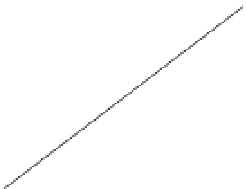Geoscience Reference
In-Depth Information
One-dimensional model
An overburden layer on a homogenous basement, and
multi-layered geological environments, are represented as
a series of
flat-lying layers. Each layer has constant thick-
ness and extends laterally to in
nity in all directions, and
each has its own (constant) physical property (
Fig. 2.46b
and
c
). The model parameters are the number of layers and
their thicknesses, and the physical properties of each layer
and the underlying basement. Variation is only possible in
one direction,
dimensional model. There is no change in the geophysical
response laterally across the surface of the 1D model.
The 1D model is useful when geological features extend
laterally well beyond the footprint (see
Section 2.6.2
)
of the
geophysical survey. It is used to model (depth) soundings;
where the variation of the response with depth is investi-
gated (see
Sections 5.6.6.1
and
5.7.4.3
)
. As described in
Section 2.8.1
,
a series of 1D models from adjacent meas-
urements may be used to create parasections, or
paravolumes.
i.e. vertically, so it is known as a one-
Two-dimensional model
For geological features having a long strike length, a model
consisting of a cross-section can be specified and the strike
extent of the model set to in
a)
Measurement
nity (
Fig. 2.47
). What consti-
tutes
depends on the geophysical method and the
depth of the source but at least 5 times would be typical.
The physical property distribution is speci
ed in only two
dimensions, i.e. depth and distance along the survey pro-
file, so it is known as a two-dimensional model. When the
geophysical data (and geology) are known to be constant
along strike, or can reasonably assumed to be, a represen-
tative pro
le perpendicular to the regional strike is selected
and can be modelled using a 2D model.
Two-dimensional models have their longest (strike) axis
horizontal and the cross-section modelled is vertical. For
shape-based models the bodies in the cross-section can be
of any shape, such as a rectangle (
Fig. 2.44c
) or a circle to
represent a cylindrical source (
Fig. 2.44e
)
, or an arbitrary
shape can be defined by specifying the coordinates of the
nodes of straight-line segments defining the shape
(
Fig. 2.44j
). For cell-based models the subsurface is defined
'
long
'
b)
Measurement
c)
Measurement
Figure 2.46
One-dimensional models of the subsurface. (a) Half-
space, (b) and (c) multiple layers of constant thicknesses and
physical properties. All models extend laterally to in
nity.
To
Pos ion (y)
Pos ion (x)
Modelled profile
2.75D
2.5D
3D
y
To
2D
x
(Modelling profile)
D
e
p
t
h
(
z
)
D
e
p
t
h
(
z
)
z
Figure 2.47
Schematic illustration of prism models of different dimensionality.









































































































Search WWH ::

Custom Search